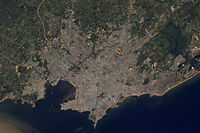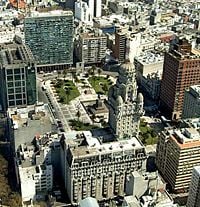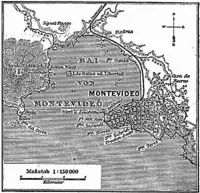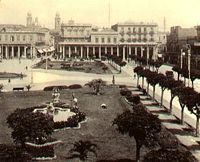Difference between revisions of "Montevideo" - New World Encyclopedia
m |
({{Contracted}}) |
||
| Line 1: | Line 1: | ||
| − | {{Started}} | + | {{Started}}{{Contracted}} |
Ray Mas{{otheruses}} | Ray Mas{{otheruses}} | ||
Revision as of 19:08, 14 September 2007
Ray Mas
- For other uses, see Montevideo (disambiguation).
| Montevideo | |
| Montevideo from the Telecommunications Tower | |
| Coordinates: 34°53′S 56°10′W | |
|---|---|
| Country | Uruguay |
| Department | Montevideo Department |
| Founded | 1726 |
| Founder | Bruno Mauricio de Zabala |
| Elevation | 43 m (141 ft) |
| Population (2004) | |
| - Total | 1,325,968 |
| - Rank | 1st |
| - Demonym | Montevideano |
| postal code | 10000 |
| Area code(s) | +02 |
Montevideo (IPA: [monteβi'deo]) is the largest city, capital and chief port of Uruguay. Montevideo is the primate city in Uruguay, the only city in the country with a population over 1,000,000. Montevideo has a privileged harbour, one of the most important in the Americas. Also, it has beautiful beaches, like Pocitos, Buceo, Malvin, Playa de los Ingleses, Playa Verde, Punta Gorda and Carrasco. Many monuments and museums cover the city, as well as historic buildings and squares. The city's mayor is Ricardo Ehrlich. According to the Mercer Human Resource Consulting, Montevideo is the Latin American city with the highest quality of life (followed by Buenos Aires and Santiago de Chile)[1]. It is among the 30 safest cities in the world [2] and the second safest capital city. [3].
Population
The current population estimates for Montevideo are 1,349,000 habitants in the city proper and 1,814,400 habitants in the greater metropolitian region.
Montivideans have very strong European origins, with Italian and Spanish descent being the most common. There are also important African descent and Jewish communities.
Montevideo's population makes up roughly 44% of the entire country of Uruguay. The surrounding province of Canelones, essentially Montevideo's suburbs and direct rural area, makes up another 12%.
Geography
Montevideo is situated in the south of the country, The geographic coordinates are 34.5° S, 56°W.
18 de Julio is the city's main avenue and extends from the Plaza Independencia, which is the junction between the Ciudad Vieja (the historical quarter) and the rest of the city, to the neighbourhood of Cordón.
History
Origin of Name
There are at least two explanations for the name Montevideo: The first states that it comes from the Portuguese "Monte vide eu" which means "I see a mountain." The second is that the Spaniards recorded the location of a mountain in a map as "Monte VI De Este a Oeste" meaning "The sixth mountain from east to west." The city's full original name is San Felipe y Santiago de Montevideo.
Early History
Montevideo was first found by Juan Diaz De Solis. He arrived in 1516. He encountered the natives living there, and was killed by them, along with the rest of his group of travelers. The Portuguese founded Colonia del Sacramento in the 17th century despite Spanish claims to the area due to the Treaty of Tordesillas. The Spanish chased the Portuguese out of a fort in the area in 1724. Then, Bruno Mauricio de Zabala – governor of Buenos Aires – founded the city on December 24, 1726 to prevent further incursions.
In 1828, the town became the capital of Uruguay.
The city fell under heavy British influence from the early 19th century until the early 20th century as a way to circumvent Argentine and Brazilian commercial control. It was repeatedly besieged by Argentinean dictator Juan Manuel de Rosas between 1838 and 1851. Between 1860 and 1911, British Owned Railway companies built an extensive railroad network linking the city to the surrounding countryside.
20th Century
During World War II, a famous incident involving the German pocket battleship Admiral Graf Spee took place in Punta del Este, 200 km from Montevideo. After the Battle of the River Plate with the British navy on December 13, 1939, the Graf Spee retreated to Montevideo's port, which was considered neutral then. To avoid risking the crew in what he thought would be a losing battle, Captain Hans Langsdorff scuttled the ship on December 17. Langsdorff committed suicide two days later. On 10 February 2006, the eagle figurehead of the Admiral Graf Spee was recovered. To protect the feelings of those still sensitive to Nazi Germany, the swastika on the figurehead was covered as it was pulled from the water.
Since 2005 the Mayor of Montevideo (styled Intendente Municipal in Spanish) has been Ricardo Ehrlich, of the Frente Amplio (Broad Front), gaining 61% of the vote in the Mayoral elections, beating Pedro Bordaberry of the Partido Colorado, who scored 27%.
Growth/economy
Montevideo began as a minor settlement. In 1860, Montevideo had a population of 37,787. By 1884, the population had grown to 104,472, including many immigrants.
During the mid-20th century, military dictatorship and economic stagnation caused a decline whose residual effects are still seen today. Many rural poor flooded the city, with a large concentration in Ciudad Vieja.
Recently, economic recovery and stronger trade ties with Uruguay's neighbours have led to renewed agricultural development and hopes for greater future prosperity.
As of 2004, the city has a population of 1.35 million out of a total of 3.43 million in the country as a whole.[1] The greater metropolitan area has 1.8 million people.
Montevideo is served by Carrasco International Airport.
Template:Panorama2
World City Formation
The city shows "some evidence" of world city formation.
Neighbourhoods
|
|
|
Education
- Instituto Preuniversitario JUAN XXIII
- Stella Maris College (Montevideo)
- The British Schools of Montevideo
- University of the Republic, Uruguay
- ORT Uruguay
- Lycée Français
- Scuola Italiana
- Deutsche Schule
- Public Primary School
- Public Secondary School
- Catholic University, Uruguay
- Instituto Preuniversitario de Montevideo - PRE/U
Sports
Montevideo hosted all the matches of the 1st FIFA World Cup in 1930. Uruguay won the tournament by defeating Argentina 4-2, and later in 1950 defeated heavy favored hosts Brazil 2-1, achieving its second World Cup Championship. Uruguay also won several olympic medals in soccer including 2 gold medals, and has won the most "Copa America" tournaments, the world's second most prestigious tournament after the World Cup (tied with Argentina at 14 wins). Its Estadio Centenario is considered a temple of world football. The city is home to two of the most important South American football clubs: Nacional and Peñarol. Consistently since its early successes, Uruguayan footballers have been among the worlds best, recently producing such soccer greats as Diego Forlan, Paolo Montero and Alvaro Recoba, and currently boasts the highest number of world class exports to the European leagues out of any country in South America including fellow soccer powerhouses Argentina and Brazil, a surprising feat when considering the population of just over 3 million is a small fraction of most other South American countries.
There is strong world-wide sentiment that the centennial anniversary Fifa World Cup tournament to be held in 2030, be played at least in part in Uruguay, namely in the Centenario Stadium which was built specifically as the innagurational stadium for the tournament of 1930, and fittingly translates to "The Centennial Stadium."
Sites of interest
- Estadio Centenario
- Palacio Salvo
- Torre de las Telecomunicaciones
- Teatro Solís
- Palacio Legislativo
- Catedral Metropolitana
- Cabildo de Montevideo
- Mercado del Puerto
- Playa Pocitos
- Parque Rodo
- Palacio Pitamiglio
Sister cities
 Québec City, Canada
Québec City, Canada Barcelona, Spain
Barcelona, Spain Montevideo, USA
Montevideo, USA Miami, USA
Miami, USA Curitiba, Brazil
Curitiba, Brazil Qingdao, PRC
Qingdao, PRC Saint Petersburg, Russia
Saint Petersburg, Russia
ReferencesISBN links support NWE through referral fees
- ↑ Ranking of Latin American cities, Quality of life section. See also La Nación -Chilean newspaper article that mentions the three Latin American cities with highest quality of life according to the MHRC 2007 investigation (Spanish)
- ↑ Property in Uruguay
- ↑ Montevideo, the second safest capital city in the world at StudyAbroadInternational.com
External links
- Montevideo official website
- (Spanish) PRESS The First Uruguayan Neighborhood and Documentatio Agency
- (Spanish)/(English) A City Built by Us All
- Many nice pictures of Montevideo
- Panoramic pictures of Montevideo
- Montevideo Hotels
- A Maverick's Odyssey - Photo blog of life in Montevideo, Uruguay.
- Uruguay Dreaming - Blog about life and customs in Montevideo and Uruguay.
-
- Mapping from Multimap or GlobalGuide or Google Maps
- Satellite image from WikiMapia
- Mapping from OpenStreetMap
- Montevideo Pop Music: Site of the band with the name of the city
| Departments of Uruguay | |
|---|---|
| Artigas | Canelones | Cerro Largo | Colonia | Durazno | Flores | Florida | Lavalleja | Maldonado | Montevideo | Paysandú | Río Negro | Rivera | Rocha | Salto | San José | Soriano | Tacuarembó | Treinta y Tres |
Asunción, Paraguay · Bogotá, Colombia · Brasília, Brasil · Buenos Aires, Argentina · Caracas, Venezuela · Cayenne, French Guiana · Georgetown, Guyana · Grytviken, South Georgia and the South Sandwich Islands · La Paz, Bolivia · Lima, Peru · Montevideo, Uruguay · Paramaribo, Suriname · Quito, Ecuador · Santiago, Chile · Sucre, Bolivia · Stanley, Falkland Islands
Credits
New World Encyclopedia writers and editors rewrote and completed the Wikipedia article in accordance with New World Encyclopedia standards. This article abides by terms of the Creative Commons CC-by-sa 3.0 License (CC-by-sa), which may be used and disseminated with proper attribution. Credit is due under the terms of this license that can reference both the New World Encyclopedia contributors and the selfless volunteer contributors of the Wikimedia Foundation. To cite this article click here for a list of acceptable citing formats.The history of earlier contributions by wikipedians is accessible to researchers here:
The history of this article since it was imported to New World Encyclopedia:
Note: Some restrictions may apply to use of individual images which are separately licensed.




